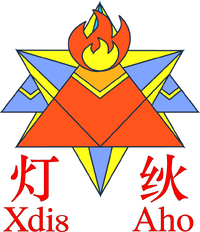Fiyifnzao (English):修订间差异
→Basic components: 移至下方 |
|||
| 第2行: | 第2行: | ||
== Subdivision of a character == | == Subdivision of a character == | ||
== Phonetic components == | |||
The pronunciation of phonetic components is loosely related to it in Modern Standard Chinese (e.g. {{x|fT}} 方, compare with MSC {{lang|cmn-Latn|fāng}}; see [[希顶官话|Shidio-Mandarin]] for more details). But some of them are fabricated with no relation to any other languages (e.g. {{x|Ni3}} 京 {{lang|cmn-Latn|jīng}}, {{x|HoH}} 时 {{lang|cmn-Latn|shí}}), pronunciation in this case usually starting with | |||
* {{x|N}} (Commonly j-, q-, y- in MSC) | |||
* {{x|5}} (Commonly x-, y-) | |||
* {{x|F}} (Commonly x-, q-) | |||
* {{x|7}} (Commonly y-) | |||
* {{x|H}} (Commonly zh-, ch-, sh-, z-, c-, s) | |||
* {{x|k}}, {{x|B}} and {{x|c}} followed by {{x|i}} | |||
Sometimes a head vowel -{{x|i}}- (e.g. {{x|di3}} 冬; Commonly after {{x|d, t, l, g, f}}) or -{{x|u}}- (e.g. {{x|Due}} 车; Commonly after {{x|j, q, x, y, z, D, s}}) is inserted into the MSC reading. | |||
== Usage == | == Usage == | ||
The prime objective in Shidinn is alphabetical writing of Chinese, i.e. without Hanzi. Fiyifnzao are merely used to borrow words from varieties of Chinese (e.g. {{x|vnuV}} “lion” from Chinese {{lang|cmn-Hans|狮}}) and East Asian languages written in Chinese characters (e.g. {{x|zAE}} “shore, beach” from Japanese {{lang|ja|渚}}). | The prime objective in Shidinn is alphabetical writing of Chinese, i.e. without Hanzi. Fiyifnzao are merely used to borrow words from varieties of Chinese (e.g. {{x|vnuV}} “lion” from Chinese {{lang|cmn-Hans|狮}}) and East Asian languages written in Chinese characters (e.g. {{x|zAE}} “shore, beach” from Japanese {{lang|ja|渚}}). | ||
2021年6月26日 (六) 10:58的版本
Fiyifnzao (Shidinn: , Fiyifnzao: 灯纟火汉字) are Chinese characters imported to Shidinn. Because of the dedication of Shidinn to deprecate homophones, the pronunciation of each Finifnzao theoretically differs from one another, which can be seen as a kind of readable lossless encoding of Chinese characters.
Subdivision of a character
Phonetic components
The pronunciation of phonetic components is loosely related to it in Modern Standard Chinese (e.g. 方, compare with MSC fāng; see Shidio-Mandarin for more details). But some of them are fabricated with no relation to any other languages (e.g. 京 jīng, 时 shí), pronunciation in this case usually starting with
- (Commonly j-, q-, y- in MSC)
- (Commonly x-, y-)
- (Commonly x-, q-)
- (Commonly y-)
- (Commonly zh-, ch-, sh-, z-, c-, s)
- , and followed by
Sometimes a head vowel -- (e.g. 冬; Commonly after , , , , ) or -- (e.g. 车; Commonly after , , , , , , ) is inserted into the MSC reading.
Usage
The prime objective in Shidinn is alphabetical writing of Chinese, i.e. without Hanzi. Fiyifnzao are merely used to borrow words from varieties of Chinese (e.g. “lion” from Chinese 狮) and East Asian languages written in Chinese characters (e.g. “shore, beach” from Japanese 渚).
